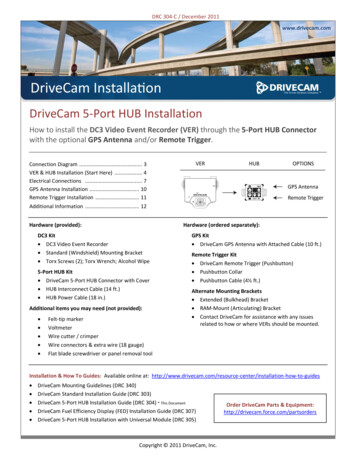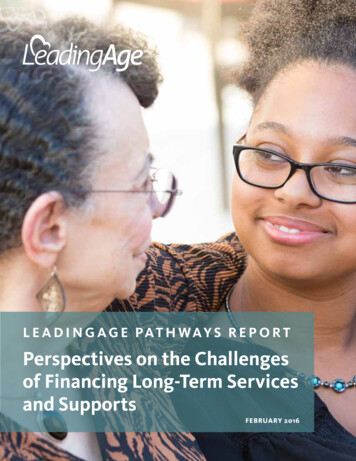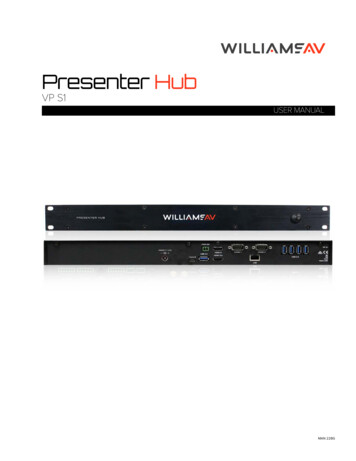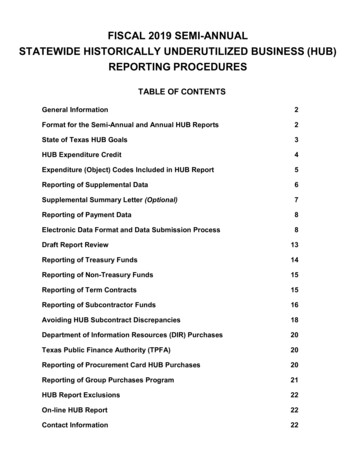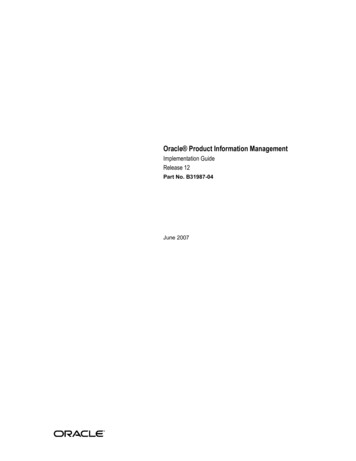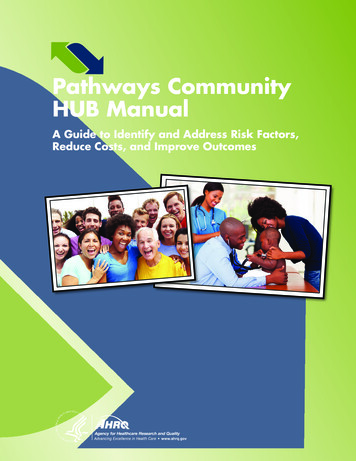
Transcription
Pathways CommunityHUB ManualA Guide to Identify and Address Risk Factors,Reduce Costs, and Improve OutcomesA
Pathways CommunityHUB ManualA Guide to Identify and Address Risk Factors,Reduce Costs, and Improve OutcomesPrepared for:Agency for Healthcare Research and QualityU.S. Department of Health and Human Services5600 Fishers LaneRockville, MD 20857www.ahrq.govDeveloped by:Community Care Coordination Learning Network and The Pathways Community HUB CertificationProgram (PCHCP)Editorial TeamMary ApplegateLaura BrennanValerie KuenkeleSarah ReddingMark ReddingSupporting PCHCP Core TeamBrenda LeathVeronica NievaAnnette PopeAHRQ Publication No. 15(16)-0070-EFReplaces AHRQ Publication No. 09(10)-0088January 2016
This document is in the public domain and may be used and reprinted without special permission.Citation of the source is appreciated.Suggested citation:Pathways Community HUB Manual: A Guide to Identify and Address Risk Factors, Reduce Costs, andImprove Outcomes. Rockville, MD: Agency for Healthcare Research and Quality (AHRQ); January2016. AHRQ Publication No. 15(16)-0070-EF. Replaces AHRQ Publication No. 09(10)-0088.The information in the Pathways Community HUB Manual is intended to assist service providersand community organizations in creating a HUB to coordinate delivery of health care and socialservices. The content was developed by the Pathways Community HUB Certification Program.This manual is intended as a reference and not as a substitute for professional judgment. Thefindings and conclusions are those of the authors, who are responsible for its content, and do notnecessarily represent the views of AHRQ. No statement in this manual should be construed as anofficial position of AHRQ or the U.S. Department of Health and Human Services. In addition,AHRQ or U.S. Department of Health and Human Services endorsement of any derivativeproducts may not be stated or implied. None of the investigators has any affiliations or financialinvolvement that conflicts with the material presented in this manual.ii
ContentsIntroduction and Purpose.1Current Difficulty in Identifying and Addressing Risk Factors.2Evidence Related to Risk Factors.3The Broken Business Model of Care Coordination.4A Way To Solve the Problem: Pathways Community HUB.6The Hub At Work - Part 1.7The Hub At Work - Part 2.9Summary of the Pathways Community HUB Model.11Elements of a HUB.11Infrastructure.11Governance.12Quality Improvement.12Sustainability.12A Step-by-Step Guide to Building a Pathways Community HUB.14Phase 1: Planning a HUB.14Step 1: Form a Planning Group.14Step 2: Create a New Umbrella Organization or Designate a Lead Agency.15Step 3: Complete Community Needs Assessment.16Step 4: Discuss Sustainability Issues and Develop a Plan To Secure Funding.18Phase 2: Creating Tools and Resources for the HUB.20Step 5: Determine Initial Focus Outcomes and Related Pathways.20Step 6: Create Supporting Tools and Documents for Care Coordinators.29Step 7: Develop Sustainable Funding Strategies for HUBs.32Step 8: Develop Systems To Track and Evaluate Performance.38Phase 3: Launching the HUB.39Step 9: Hire HUB Staff.40Step 10: Train and Organize CCCs and Staff at Participating Agencies.40Step 11: Conduct a Community Awareness mmunity HUB Template.47Community Care Coordination Learning Network.48Primary Resources for Current Evidence.51Sample Pathways Forms.56Sample Checklists.58Glossary of Abbreviations Used in This Report.65Other Resources.66iii
Introduction and PurposeThe Pathways Community HUB Manual is designed as a guide to help those interested in improvingcare coordination to individuals at highest risk for poor health outcomes. The Pathways CommunityHUB (HUB) model is a strategy to identify and address risk factors at the level of the individual, butcan also impact population health through data collected. As individuals are identified, they receive acomprehensive risk assessment and each risk factor is translated into a Pathway. Pathways are tracked tocompletion, and this comprehensive approach and heightened level of accountability leads to improvedoutcomes and reduced costs.1The most important functions of the Pathways Community HUB are to: Centrally track the progress of individual clients (to avoid duplication of services and identify andaddress barriers and problems on a real-time basis); Monitor the performance of individual workers (to support appropriate incentive payments); Improve the health of underserved and vulnerable populations; and Evaluate overall organizational performance (to support appropriate payments, promote ongoingquality improvement, and help in securing additional funding).Community-based care coordination has a critical role in ensuring that individuals at risk connect tothe evidence-based interventions and services that will improve their outcomes. The current siloes andfragmented approaches to care coordination that exist in communities often result in duplication ofservices, ineffective interventions, and uncoordinated care.The HUB provides centralized processes, systems, and resources to allow accountable tracking of thosebeing served, and a method to tie payments to outcomes. This guide describes the model, infrastructureneeded, and implementation strategies through a step-by-step approach.Three overarching principles make up the foundation of the HUB model:1. Find: Identify individuals at greatest risk and provide a comprehensive assessment of all health,social, and behavioral health risk factors.2. Treat: Ensure that each identified risk factor is assigned to a specific Pathway that will ensure therisk factor is addressed with an evidence-based or best practice intervention (e.g., prenatal care,specialty care, parenting education, housing, food, clothing).3. Measure: Completion of each Pathway confirms that the risk factor has been successfullyaddressed. Measurement also includes other outcomes that involve multiple risk factors(e.g., improvement in chronic disease, reduction in emergency department [ED] visits andhospitalizations, adult education, employment).The intended audience includes all those involved in coordinating care for individuals at risk for poorhealth outcomes. Key stakeholders include but are not limited to: Federal, State, and local government agencies. Community-based organizations using community health workers (CHWs) or community carecoordinators. Safety net clinics.1
Health plans. Accountable care organizations. Social service agencies. Local public health departments. Private practitioners. Hospitals. Public health departments. Charitable organizations. Private practitioners and businesses. Individuals served and the communities that serve them.Current Difficulty in Identifying and Addressing Risk FactorsThe United States spends significantly more money per capita on health care services than any othernation in the world.2 The reality is that the United States lags behind most other developed countries interms of key outcome measures, including infant mortality, health equity,3 and patient perceptions ofsafety, efficiency, and effectiveness. The primary sources of these adverse health and social outcomes arerisk factors.4,5 If risk factors are the source of poor outcomes and related expense, why isn’t the focus ofour health and social services system the coordinated and comprehensive identification and reduction ofrisk?The purpose of the HUB is to identify and address risk factors—primarily at the individual level but alsoat the community-population level. Finding the specific individuals within communities who are mostlikely to have a poor health outcome, addressing their specific needs, and accountably measuring theirresults will influence the overall health of the larger community. The first community that piloted theHUB model showed a countywide reduction in low birth weight by targeting the women most likely tohave a poor birth outcome.Published and ongoing research shows that community care coordinators can successfully find andengage the right individuals, complete a comprehensive risk assessment, and then partner with themto overcome barriers to successful outcomes.1 This work can be done with accountability, culturalcompetence, and a pay-for-performance approach that results in reduced risk, better outcomes, andreduced cost.1,6,7The HUB model requires that we look at risk from a new perspective. Some of the questions we need toask include:1. Who is most at risk in our community?2. What risk factors tie to the adverse health and social outcomes we need to address?3. How can we comprehensively assess risk for each individual served?4. In addition to identifying, tracking, and improving individual risk factors, how can we look atpopulation health?5. How can we measure the economic benefit?2
Evidence Related to Risk FactorsCare coordination is currently part of many health and social service funding streams, but it isusually not evidence based. Evidence-based approaches are at the foundation of our modern healthcare system, but the same rigor has not been applied to care coordination. There is great potential toimprove outcomes by using key strategies of comprehensive risk assessment, identification and trackingof risk factors, and payment tied to reduction of risk.8Five percent of the population represents more than half of the total health care cost.9 We need tofind and engage vulnerable individuals with proven strategies to improve health equity and outcomes.Cultural competence is an essential factor in the workforce deployed to achieve this goal.Risk factors related to health care represent less than 15 percent of the risk factor burden. Ifwe were able to identify the most at-risk individuals and confirm that they received the best healthcare possible, it is estimated that we would only see a 10 to 15 percent improvement in their healthoutcomes.4 Social determinants of health represent the largest percentage of the drivers behind manypoor health outcomes.4,10 Therefore, it is important to conduct a comprehensive risk assessment toidentify and quantify all the risk burden an individual faces. In addition, accountability and pay-forperformance strategies can be used to confirm that all identified risk factors are addressed and resolved.1Fragmented approaches to care coordination are usually not effective. Care coordination is alreadypart of many local, State, and Federal health and social service funding streams, but it is delivered ina silo-based structure. Multiple care coordinators can be assigned to one person based on the specificneeds that care coordinator is addressing. For example, one care coordinator might work with a clientto address effective use of her asthma medication puffer, while another might address infant safety, andstill another might address food issues or domestic violence. Across the spectrum of health, social, andbehavioral health services, a comprehensive approach centered on individuals and their risk factors isneeded to achieve better health, social, and economic outcomes.11Some risk factors are considered to be “upstream” and some are “downstream.” When dealingwith downstream risk, the damage has been done, and the care coordinator is working to minimizefurther damage. For example, an adult with a long history of smoking and severe chronic obstructivepulmonary disease might experience multiple hospital admissions. Upstream risk factors are those thatcan have an intervention before damage is done. In this case, a healthy newborn baby with no medicalissues may leave the hospital to go home to a house full of smokers. Intervention at this point hassubstantial potential to affect health and related health care expenses many years later.Lack of insurance and access to health care is a critical component of risk. Medicaid expansionunder the Affordable Care Act has significantly increased the number of individuals who now haveinsurance.12 Unfortunately, some of the most vulnerable individuals at highest risk do not sign up. Carecoordination is an important component to address this risk factor as part of a comprehensive approachto risk reduction.Barriers for people who are insured. Health insurance is critical, but barriers still exist for manyindividuals with insurance. Some of those barriers include inability to navigate the complex physical andmental health care systems, high copayments and deductibles, lack of information on how to use theirinsurance, and other issues such as lack of transportation, inadequate housing, and difficulty meetingother basic needs.133
Disparate level of risk for racial and ethnic minority groups. Racial and ethnic minority populationsface additional barriers leading to poorer health outcomes. African-American women have substantiallyhigher rates of low birth weight (LBW) babies,14 while Hispanics have disproportionate rates ofdiabetes.15 Unequal access to care is one factor leading to poor hypertension control among Hispanicpopulations.16 Risk factors involved in accessing care can include language and cultural differences,mistrust of the health care system, financial constraints, and racism encountered within the health andsocial systems of care.Risk factors for those living in rural areas. Individuals living in rural areas represent 20 percent of thepopulation, yet only 9 percent of practicing physicians work in these areas.17 Therefore, rural residentsmust often travel long distances for care and can experience long waits at clinics. Many do not receiveneeded care in a timely manner.18 Basic social supports and services (e.g., medical and social serviceproviders, cell phone service, transportation) may not be as readily available in rural areas.Risk factors for other groups. Other high-risk populations have specific needs that must be addressed.Some groups to consider include adolescents, those with behavioral health conditions, individualsleaving prison, and individuals with high medical debt. For example, care coordination using Pathwayshas been used in Muskegon, Michigan, to reduce rates of recidivism for ex-offenders.Not identifying, assessing, and addressing risk factors for individuals in a timely manner has two majorconsequences. First and foremost, the consequence is human suffering. Second, costs are significantlyhigher because delays in risk factor intervention and prevention result in expensive and catastrophichealth and social outcomes such as frequent ED visits, repeat hospitalizations, and failure to finishschool.The Broken Business Model of Care CoordinationThe process of identifying at-risk individuals and connecting them to the health and social services theyneed is often referred to as care coordination. Care coordination is a broad term that is often thought ofas a process that occurs within the health care system. The HUB model specifically addresses communitycare coordination, which can be defined as the coordination of services beyond the “walls” of the healthcare system. A community care coordinator (CCC) in the HUB model is trained to meet individualsin their homes or in a community setting to address all their identified issues. These needs may includehelp with housing, transportation, employment, and education in addition to accessing health careservices.Care coordination occurs within many different and most often isolated domains of the health,behavioral health, and social service system. The current business model for delivering care coordinationservices remains inadequate. For example, it is most common for care coordination services to focus on“activities” that may or may not produce positive outcomes. And while more than one organization mayprovide care coordination services within a given geographic area, generally little or no collaborationoccurs across these programs. Individuals fall through the cracks and efforts are duplicated. A high-riskpregnant woman may have multiple care coordinators who do not interact with each other and anotherhigh-risk person may have no care coordinator.Three fundamental business model problems exist with the current approach to care coordination—lack of meaningful work products, duplication of effort, and failure to focus on those most at risk. Thefragmentation and duplication of services and poor outcomes resulting from poor care coordinationincrease health care costs.4
The care coordination services purchased often have no confirmed benefit to the individual served.Most care coordination services are purchased through local, State, and Federal government fundingstreams. These contracts typically purchase “work products” that do not confirm a comprehensiveapproach to the effective identification of and intervention with an individual’s risk factors. Paymentsare based on process measures, such as number of individuals on a case list, visits or phone calls made, ornotes charted.Duplication of care coordination is a burden to the budget and the individual served. Membersof the Pathways Community Care Coordination Learning Network (CCCLN) have reportedsituations where clients have had 10 or more care coordinators at one time. It is quite common for anat-risk individual to have four or five care coordinators. In most communities, these services are notcoordinated and result in significant duplication. Care coordination can cost up to 2,000 or more peryear per client served.At-risk individuals have reported that it is challenging to have multiple people and agencies in theirhomes collecting personal information and sometimes offering conflicting information. There maybe times when it is appropriate and necessary to have more than one care coordinator in a home, butthe reasons should be clearly documented. Communitywide standards for care coordination can helpidentify and eliminate unnecessary duplication of services, leading to improved costs and outcomes.There is no requirement or incentive to focus on high-risk individuals and to ensure that eachrisk factor is addressed. It takes less time, expense, and cultural competency skills to serve lower riskpopulations. Contracts that do not require services to those at greatest risk encourage agencies to “cherrypick” by serving low-risk individuals and avoiding those with the greatest need.For example, in current funding models, a care coordination program may be working to confirm that80 percent of children in a defined population have received lead testing. Most children (85 percent)may be relatively easy to reach. However, the remaining 15 percent of children and families may havelanguage barriers, lack telephones, or mistrust care coordinators who are not from their neighborhood.If a care coordination program serves higher risk individuals, then they will have to work harder,provide more hours of service, and ultimately make less money serving them under current contractingstrategies.Fixing these problems requires a fundamental change in the way care coordination contracts are written.Payments need to be scaled to recognize the number of risk factors an individual has and the time,resources, cultural competence, and skills needed to effectively serve those at greatest risk. We need tobuild a system of care with incentives to seek out and effectively serve those at greater risk instead of ourcurrent system with unintentional financial incentives to avoid them.American business has developed many service, product delivery, and tracking structures that supportaccountability, quality, and confirmed results. Airports, package delivery firms, technology companies,and other business models hold tremendous examples. Business leaders have brought their insights andinnovations to the development of the Pathways Community HUB model.The business concept of “value stream analysis” works to identify and select the best value alternativesfor designs, materials processes, and systems to achieve more effective products/results. This concept wasoriginally applied to manufacturing and led to a transformative improvement.195
In a parallel manner, can the health and social service system identify each component needed to achievea positive health or social outcome? Can we then identify financial and programmatic strategies thatfocus interventions on the populations most likely to benefit from them effectively and efficiently? Canwe comprehensively identify and address each risk factor in a business model approach?American business and manufacturing score at the top for efficiency and effectiveness withininternational rankings. In contrast, American health and social service systems and related expenses ranknear the bottom. Business system models combined with a community-connected, culturally competentapproach represent a substantial opportunity for significant improvement.According to the latest National Standards from the Pathways Community HUB Certification Program(PCHCP), HUBs must demonstrate both cultural competence and a business model approach thatensures a comprehensive assessment and documentation of intervention for all risk factors identified.Fifty percent or more of the HUB’s funding must be tied to specific health and social service outcomesproduced. This accountability of tying dollars to specific results has been demonstrated to produce betteroutcomes, improved documentation, and increased efficiency.1,6A Way To Solve the Problem: Pathways CommunityHUBBuilding a Pathways Community HUB will bringtogether an accountable team of community-basedagencies that deploy CCCs to reach out to thoseat greatest risk, assess their risk factors, and ensurethat they connect to care. As individual risks arereduced, population-level health improves andoverall costs are reduced.The codevelopers of the HUB model spent severalyears in Alaska working with community healthworkers (CHWs). Alaska has a large network ofcertified CHWs located within high-risk communities. Alaska has progressed from reporting someof the worst infant mortality statistics in the United States in the 1960s to some of the best today.The CHW experience in Alaska and its regional supporting network were key building blocks in thedevelopment of the HUB model.20The Pathways model was the precursor to the Pathways Community HUB model. Pathways weredeveloped by the Community Health Access Project (CHAP) in the late 1990s, about the same timethat CHW programs were being established in Ohio. CHAP created Pathways as a response to fundersasking how the work that CHWs did could connect to improved outcomes.CHAP designed and began using Pathways for all their enrolled clients in 2000 and started to seenoticeable changes in outcomes, specifically around LBW. Pathways were simply a tool used to identify,track, and measure each risk factor through to a measurable outcome. Pathways were triggered by thecomprehensive risk assessment completed by the CHW when a client was enrolled. CHAP worked withfunders to change all contracts to outcome-based payment and developed strategies for payments relatedto successful Pathway completion.6
The success of implementing Pathways within a single agency, CHAP, led to the realization that themodel would be more successful if it could be used by all the agencies within the community workingwith high-risk populations. CHAP worked with key stakeholders in Richland County, Ohio, includinglocal government agencies, community-based organizations, health care providers, community leaders,and others, to develop the first HUB approach.The CHAP Pathways Community HUB grew out of this first attempt to bring all care coordinationagencies together within the county. The HUB is the network that brings together care coordinationagencies and provides the infrastructure that is missing in most communities. The Pathways are thespecific tools the HUB uses to track an individual’s identified risk factors through to a measurableoutcome.HUB initiatives then developing in Toledo and Cincinnati, Ohio; Albuquerque and Rio Arriba, NewMexico; Oregon; Michigan; and other locations have substantially informed and shaped the model.Today, the HUB model represents a national learning and quality improvement network organizedby the Agency for Healthcare Research and Quality and supported through a broad base of fundingstreams. Certification and related collaborative efforts among national health improvement initiativesprovide an opportunity for continued improvement, development, and spread.The Hub At Work - Part 1See the HUB Community Template in the Appendix for an illustration of how the HUB works.Following is an example of the HUB in action.Leah is 17 and pregnant. She is staying at a friend’s house for a few days because her parents threw herout of the house for getting pregnant. Her friend has heard of a CHW named Kim who helped hercousin when she was pregnant last year. Her cousin has Kim’s number, and they place a call.Regional organization and tracking of care B—Client Coordination Demographic Intake Initial Checklistassign Pathways Regular home visits—checklists and Pathways completed Discharge when Pathways complete (no issues)7
Kim works for one of the local care coordination agencies (CCAs), Community Vision, that is partof the HUB network. There are a total of eight CCAs connected to the HUB that work with at-riskpregnant women.Kim meets the requirements to serve as a CCC in her HUB as she has been trained and certified as aCHW. Kim is from the same community where Leah lives. The following day, Kim meets with Leahat her friend’s house. Immediately, Kim explains the program and obtains an appropriate release ofinformation that protects Leah’s personal health information. Kim then checks in with the HUB tomake sure that there is not another CCC from one of the other agencies within the HUB networkalready working with Leah. Using tablet-based technology, Kim determines that Leah is not yet enrolledin the HUB and she is eligible for HUB community care coordination.In a manner that is consistent across the HUB network, Kim goes through a checklist with Leah toevaluate her medical, behavioral health, and social risk factors. As Kim works through the checklistwith Leah and comprehensively identifies risk factors, she begins to discuss options for housing, food,clothing, medical care, and other supportive services. Kim begins to encourage her to client to reenrollin school. Through conversation, Kim learns that Leah has always wanted to be a nurse and had beenm
Pathways Community HUB Manual is intended to assist service providers and community organizations in creating a HUB to coordinate delivery of health care and social services. The content was developed by the Pathways Community HUB Certification Program. This manual is intended as a reference and not as a substitute for professional judgment. The
